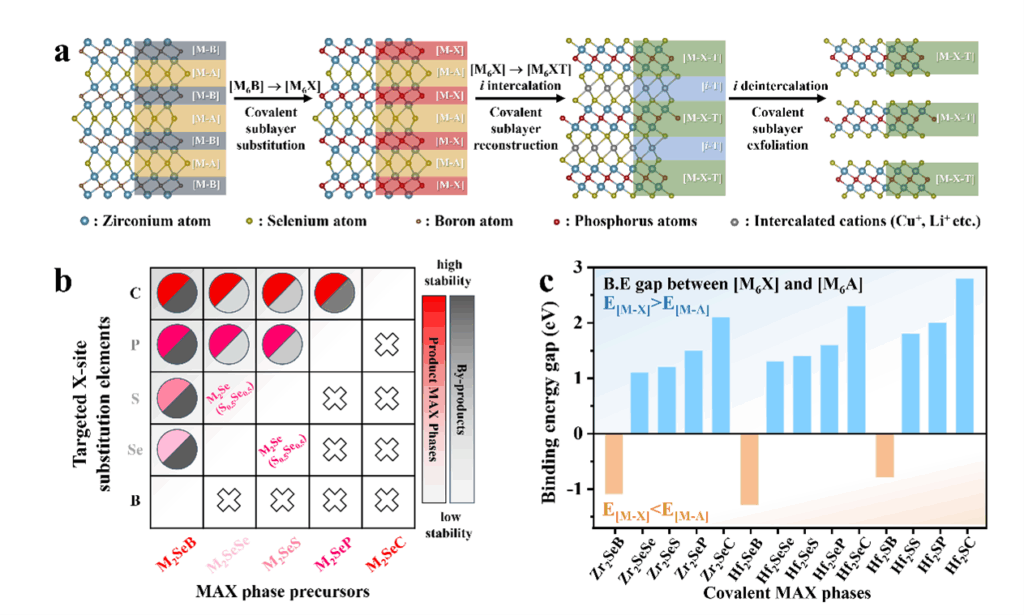
In a groundbreaking advancement, a research team led by Prof. HUANG Qing at the Ningbo Institute of Materials Technology and Engineering (NIMTE) of the Chinese Academy of Sciences has developed an innovative method to modify the internal layers of MAX phases. This discovery could pave the way for the creation of novel two-dimensional (2D) layered materials with significant technological applications.
MAX phases, known for their unique chemical formula Mn+1AXn, involve early transition metals like titanium, main-group elements such as aluminum or silicon, and carbon or nitrogen. The layered structure of these materials, characterized by strong metal-carbon/nitrogen layers interspersed with weaker “A” layers, makes them ideal candidates for developing 2D materials.
Revolutionizing 2D Material Synthesis
The potential applications of 2D materials, which are only a few atoms thick, are vast, ranging from batteries and catalysts to electromagnetic interference shielding. A well-known subset of these materials, MXenes, is typically produced by etching MAX phase crystals to remove certain atoms. This process involves using hydrofluoric acid or Lewis-acidic molten salts to selectively remove metallic A-site atoms like aluminum and silicon.
However, some MAX phases contain strongly covalent sublayers where non-metallic main-group elements occupy the A sites. The covalent nature of both M-A and M-X bonds in these phases has traditionally impeded the etching process, preventing the transformation into 2D MXenes.
Innovative Structural Editing
Published in Nature Synthesis, the study reveals significant chemical reactivity differences between distinct covalent sublayers within MAX phase crystals. By leveraging these differences, the research team achieved selective structural editing of both M-A and M-X covalent sublayers, leading to the creation of new layered inorganic materials and 2D nanomaterials through ion intercalation.
“By precisely controlling the total formation enthalpy of a well-designed reaction with a targeted sublayer, we enabled the targeted replacement of the X site with non-metal elements such as B, Se, S, P, and C,” the researchers explained.
Furthermore, Lewis acidic cations can reduce the M-element oxidation state in M-X sublayers, allowing for additional non-metal attachments like S/Se. This transformation process converts non-van der Waals MAX phases into van der Waals layered materials.
Implications for Future Technologies
Using these structural editing strategies, the team successfully synthesized a new class of 2D materials, termed early transition metal chalcogenide carbides/nitrides (TMXC). These TMXC lattices integrate features of MXenes and transition metal dichalcogenides (TMDs), with X elements including C, N, B, P, S, and Se.
Theoretical calculations and experimental results indicate that editing the X-element in the M-X covalent sublayer effectively modulates the intrinsic electronic structure of the MAX-derived 2D TMXCs. This breakthrough offers a new pathway for the structural editing and 2D exfoliation of covalent-bonded ternary layered compounds, with promising applications in high-temperature electrochemical energy storage devices and catalysis.
Support and Future Directions
This pioneering research was supported by the National Natural Science Foundation of China and the Ningbo Young Scientific and Technological Innovation Leading Talent Project, among others. The implications of this study are profound, offering a glimpse into the future of materials science and its potential to revolutionize various technological sectors.
As the scientific community continues to explore the possibilities of 2D materials, this development represents a significant leap forward, potentially unlocking new functionalities and applications that were previously unattainable. The journey of transforming MAX phases into advanced 2D materials is just beginning, and its impact on technology and industry could be transformative.





